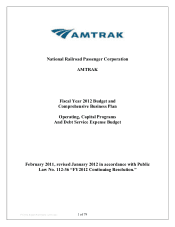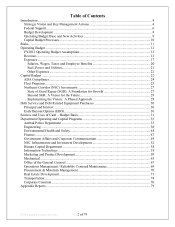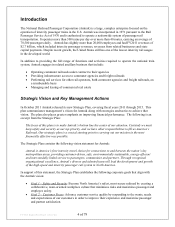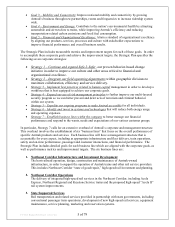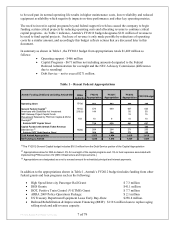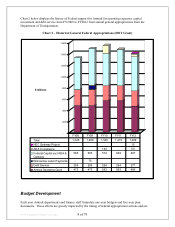Amtrak 2012 Annual Report Download - page 6
Download and view the complete annual report
Please find page 6 of the 2012 Amtrak annual report below. You can navigate through the pages in the report by either clicking on the pages listed below, or by using the keyword search tool below to find specific information within the annual report.
4. Commuter Services
Rail transportation and related services provided as a contractor to local or regional commuter
authorities, including passenger train operations, equipment maintenance and maintenance-of-
way, as well as contract management services for access and other cost-sharing agreements that
allow commuter agencies to utilize Amtrak property or services.
5. Long-Distance Services
The operation of Amtrak’ s national network of 15 interstate routes of 750 miles or more that
connect communities with the nation’ s major regions.
6. Corporate Asset Development
The development and commercialization of latent Amtrak assets, such as real estate, mechanical
services, technical expertise, intellectual property and other resources.
The implementation of the six business lines began in early fiscal 2012 with the naming of senior
management for the NEC Infrastructure and Investment Development (NEC-IID) business line. The
completion of this corporate realignment will continue throughout fiscal 2012 and will continue to mature
in subsequent years.
Such reorganization necessitates significant changes to the existing corporate structure and its employees.
With the establishment of the NEC-IID the company announced the dissolution of its former Policy &
Development and High Speed Rail organizations, which impacted more than fifty management
employees. The company has also announced that major reorganizations are in development for its
Government Affairs Division, Marketing & Product Management Division and its Operations Division,
which includes the Transportation (train operations), Mechanical (fleet maintenance) and Engineering
(infrastructure maintenance) departments. The company expects that the organizational realignments
taking place through 2012 will result in a reduction in the number of non-agreement employees across all
departments, and a Reduction in Force is expected to begin in January 2012.
In order to ease the impact of a Reduction in Force, Amtrak offered a Voluntary Separation Incentive
Program (VSIP) to all non-agreement employees with at least one year of service who wished to
voluntarily leave the company. The VSIP offered severance pay of up to sixteen weeks based on length
of service, as well as up to one year of health care coverage, through COBRA, again based on length of
service. A total of 174 employees applied for the VSIP and the company accepted 161 of the
applications. These employees, whose aggregate annual salaries totaled $14.9 million, ended their
Amtrak employment by December 30, 2011. Some of these vacated positions may be filled by employees
that are displaced as the company reorganizes, some may be filled externally, and others will be
abolished.
Federal Support
FY2012 Budget Post Board 1.20.12.doc 6 of 79
As Table 1 below demonstrates, Amtrak has received decreasing levels of federal funding in recent years.
During this period, through revenue growth and cost control efforts, the company’ s operations have
absorbed hundreds of million of dollars in inflationary costs including contractual wage increases for
agreement employees, volatile and increasing energy prices, and rapidly rising health care costs. While
operational cost pressures may be offset with revenue growth and other management actions, decreasing
federal appropriations have more detrimental impact on the capital programs. The recent capital
appropriation levels allow for little more than maintaining the current status of the infrastructure and
rolling stock; there are no available funds for addressing deferred maintenance, investing in
improvements that would grow the business, or replacing aged rolling stock. Rolling stock that continues

